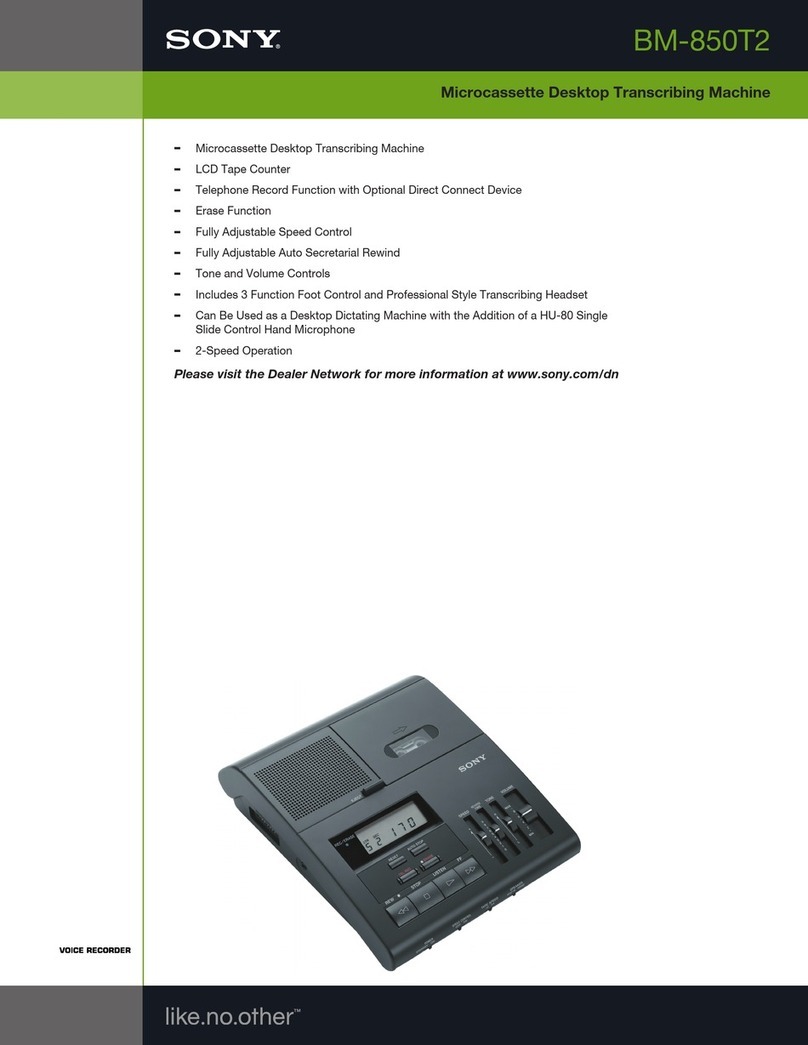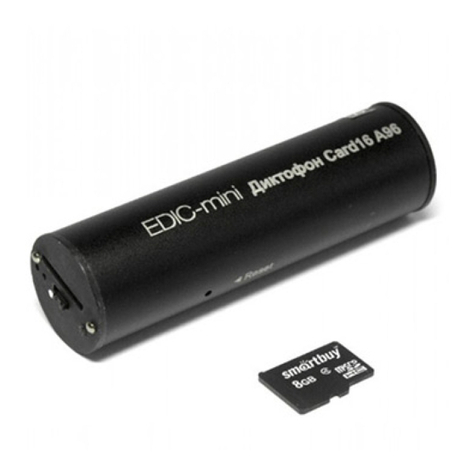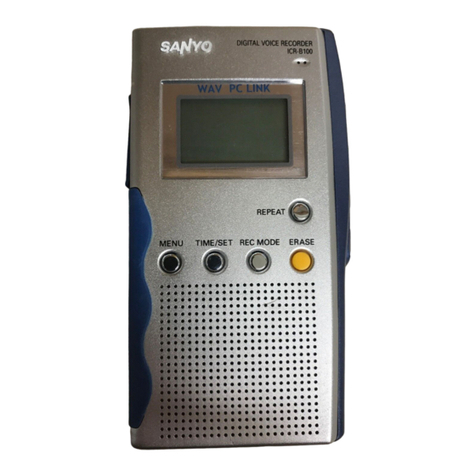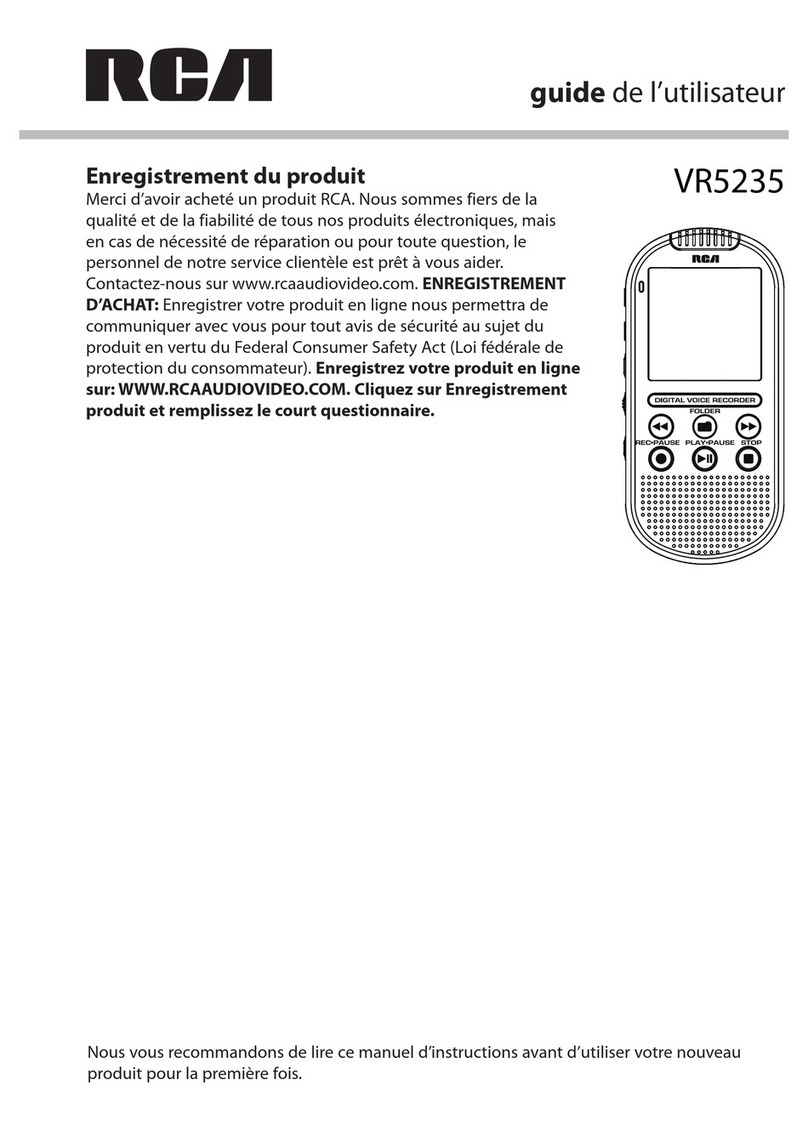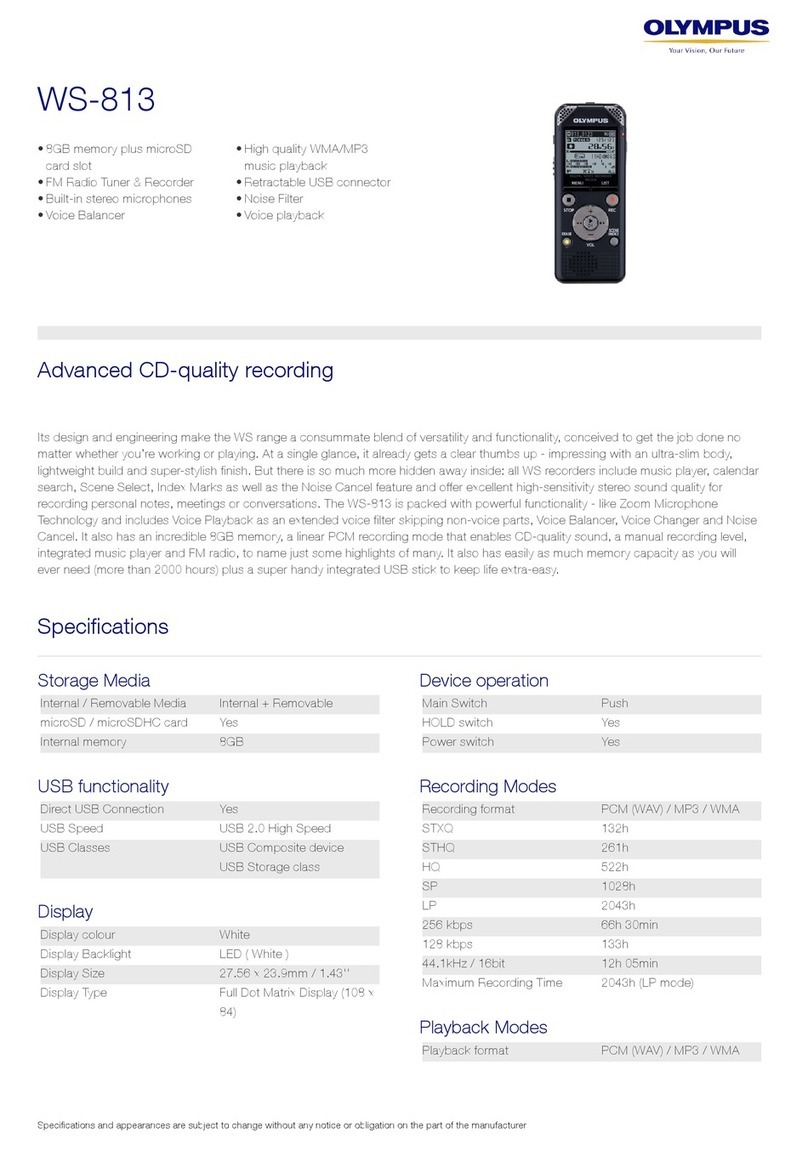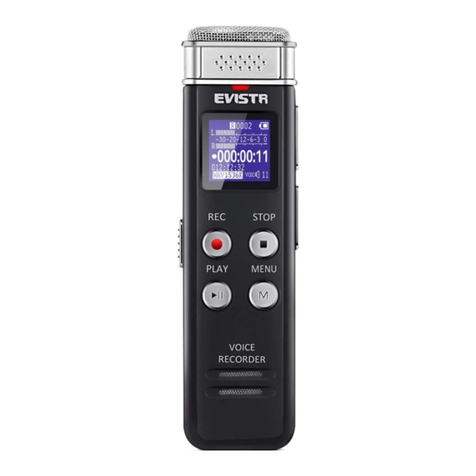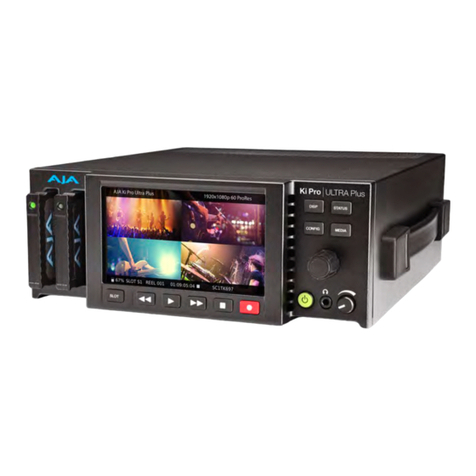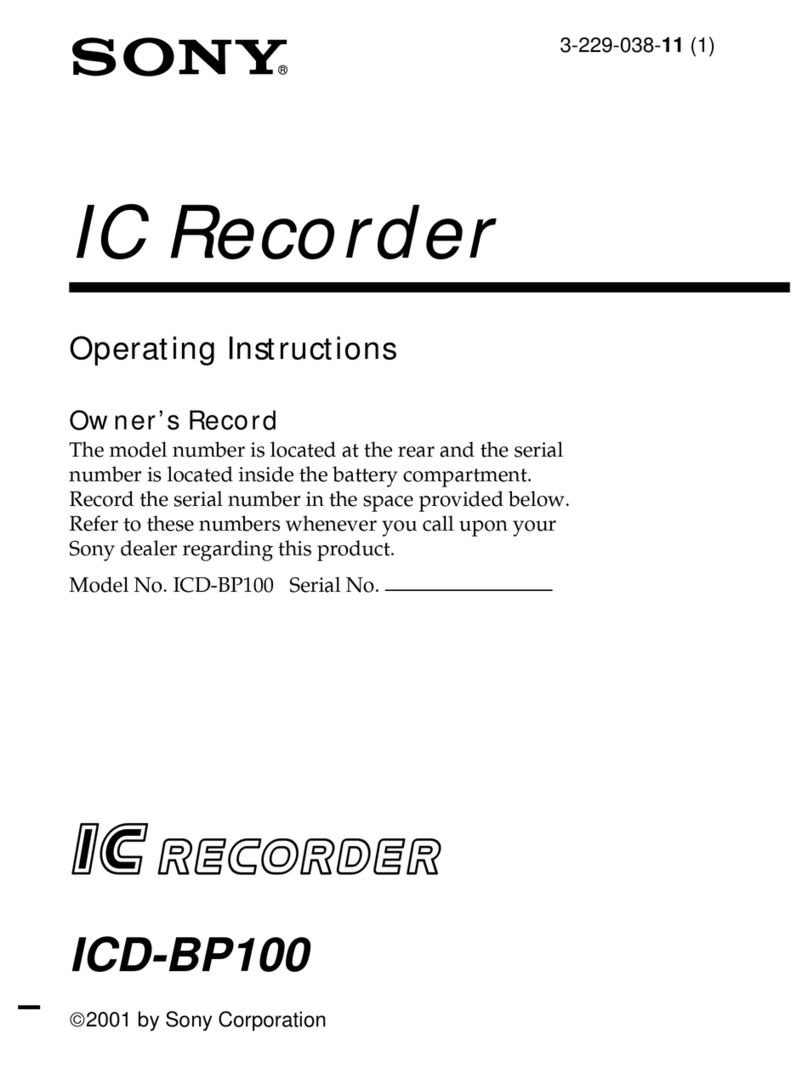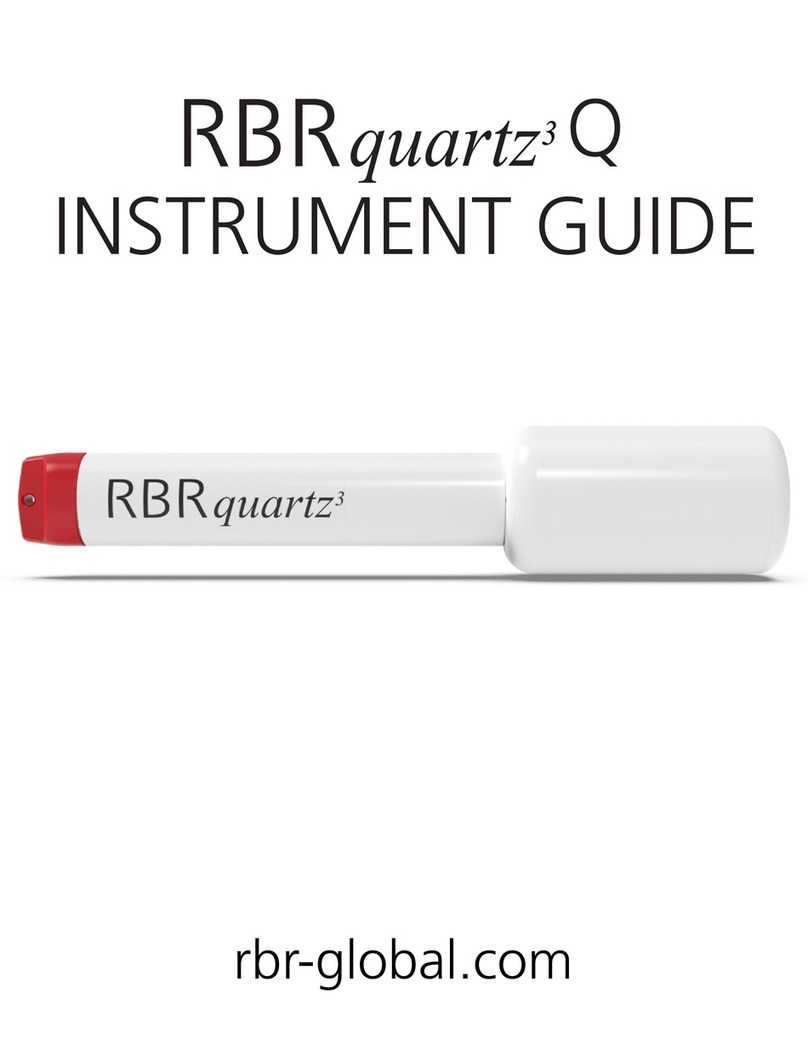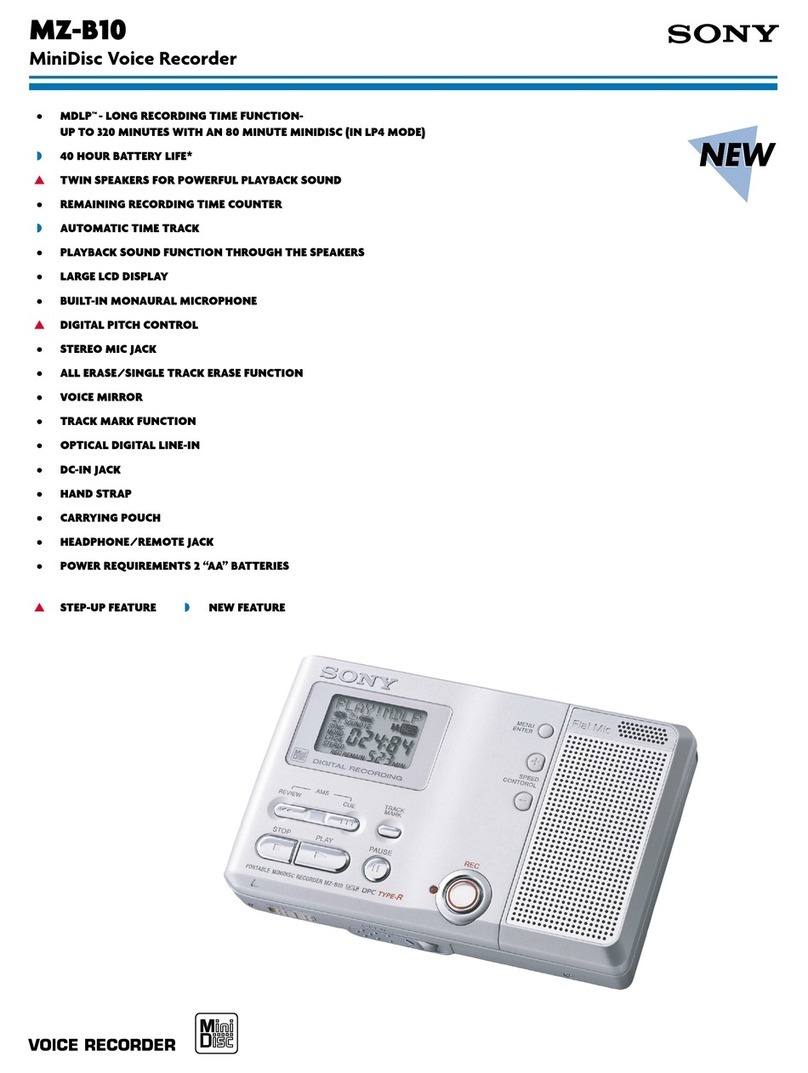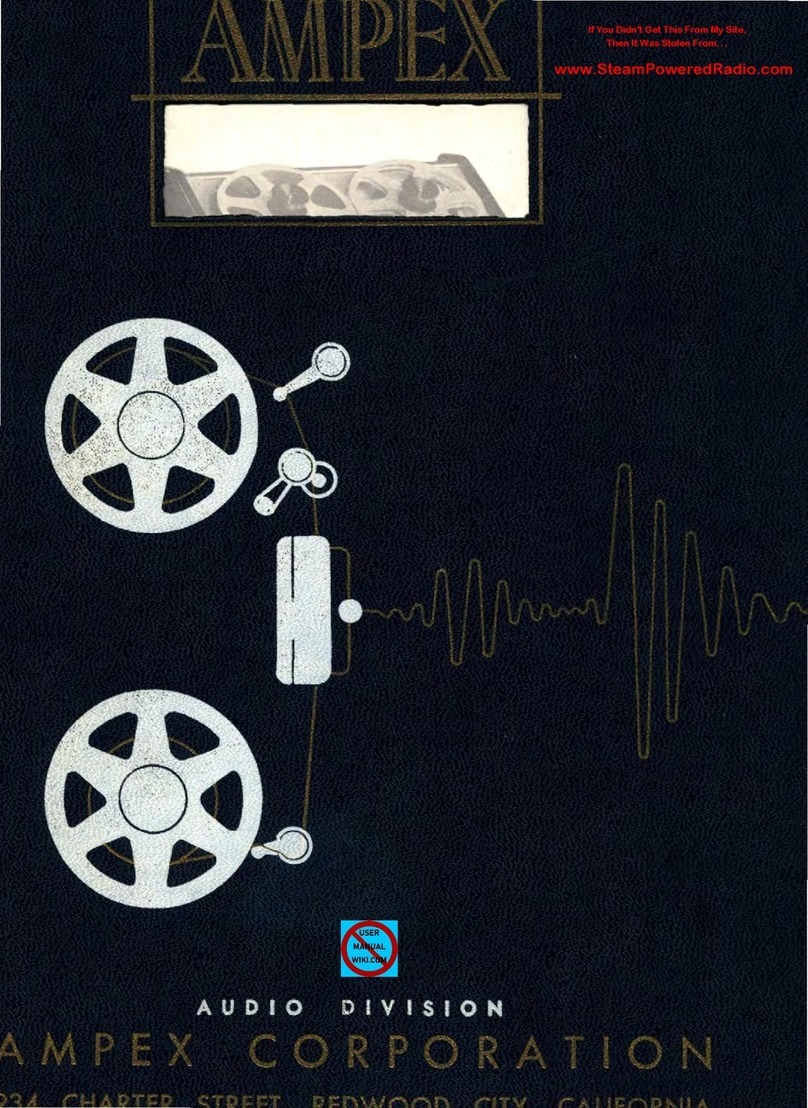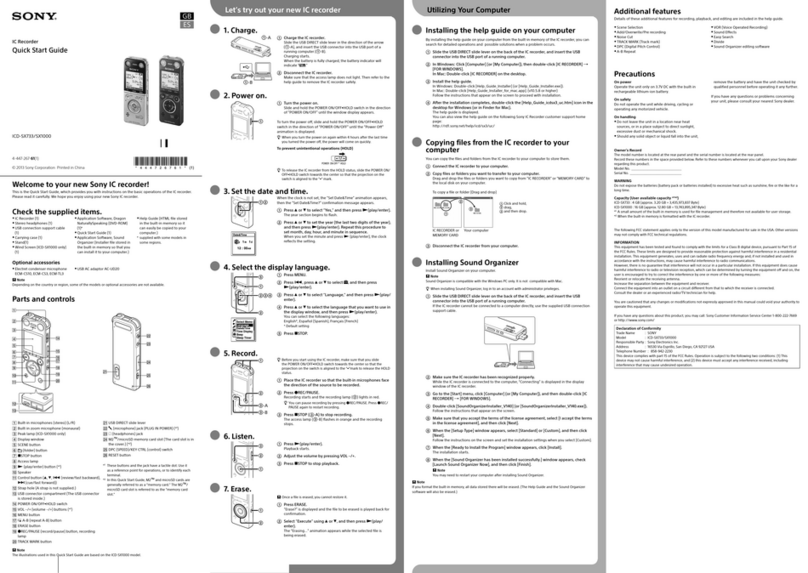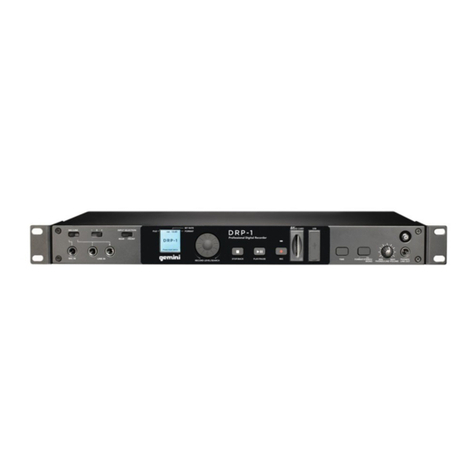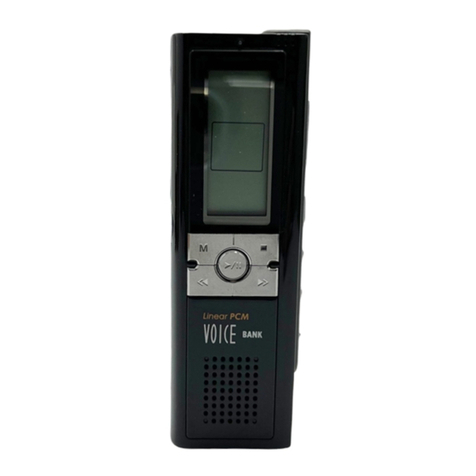Sonosax SX-R4 User manual

PROFESSIONAL PORTABLE
MULTITRACK RECORDER
SONOSAX
SX-R4
USER INTERFACE
Firmware version 4.2
Audio equipment manufacturer
SONOSAX SAS S.A.
Ch. de la Naz 38
1052 Le Mont s/Lausanne
Switzerland
Tél: +41 21 651 0101
Fax: +41 21 651 0109
Web: www.sonosax.ch / www.sonosax.com
Edition: May 2012

SONOSAX SX-R4 User interface V4.2 Page 2 de 32
TABLE OF CONTENT
1. INTRODUCTION ..................................................................................................................................................3
2. SWITCHING ON THE UNIT .................................................................................................................................3
2.1.1 Switching Off the unit ............................................................................................................................................ 3
3. PRINCIPLE OF OPERATION ..............................................................................................................................4
3.1.1 ARCHITECTURE - AUDIO PATH......................................................................................................................... 5
3.2 RECORDER MODE..............................................................................................................................................6
3.3 PLAYER MODE....................................................................................................................................................7
3.3.1 Contextual menu in Player mode .......................................................................................................................... 9
3.4 ADJUSTING THE HEADPHONE LEVEL...........................................................................................................10
3.5 SOLO MONITORING .........................................................................................................................................10
4. CONTEXTUAL MENU........................................................................................................................................11
4.1 MONITORING.....................................................................................................................................................12
4.1.1 Saving the configurations [PRESET] .................................................................................................................. 12
4.2 LINE OUT ...........................................................................................................................................................12
4.3 LAST TAKE........................................................................................................................................................13
4.4 TAG LAST TAKE ...............................................................................................................................................13
4.5 UNIT STATUS ....................................................................................................................................................14
4.6 SETUP (CONFIGURATION'S MENUS) .............................................................................................................15
4.6.1 MENU's Tree Structure ....................................................................................................................................... 16
4.6.2 ROUTING SETTING........................................................................................................................................... 17
4.6.3 RECORD SETTINGS ......................................................................................................................................... 18
4.6.4 INPUTS SOURCE .............................................................................................................................................. 20
4.6.5 TIME CODE........................................................................................................................................................ 21
4.6.6 USER SETTINGS ............................................................................................................................................... 22
4.6.7 SYSTEM SETTINGS .......................................................................................................................................... 22
4.7 BROWSE FILES.................................................................................................................................................25
4.8 METADATA........................................................................................................................................................26
4.9 SWITCH OFF .....................................................................................................................................................27
5. MANAGING THE SX-R4 ...................................................................................................................................28
5.1.1 Formatting the Hard Disk and CompactFlash card ............................................................................................. 28
5.1.2 Disk fragmentation .............................................................................................................................................. 28
5.1.3 USB 2.0 connection ............................................................................................................................................ 28
5.1.4 Alarms................................................................................................................................................................. 29
5.1.5 Errors handling.................................................................................................................................................... 29
5.1.6 Software up-date procedure................................................................................................................................ 30
6. APPENDIX..........................................................................................................................................................31
Example of a USER SETTING file ......................................................................................................................31
Organization on the HD and the CF Card ...........................................................................................................32

SONOSAX SX-R4 User interface V4.2 Page 3 de 32
1. INTRODUCTION
This manual describes the user interface, the operating instructions and all functionalities related to the
Firmware version 4.2
For all information's concerning the hardware, powering information's connectors diagram, specifications etc
please refer to the SONOSAX SX-R4 User Manual "Hardware"
2. SWITCHING ON THE UNIT
Press simultaneously the Toggle switch and the Joystick to the right to turn on the SX-R4, a boot up screen
is displayed for approx. 2 seconds.
If the date of the day has changed when powering up the SX-R4, a message is posted asking your to
confirm the new working day; select [YES] to confirm or [NO] to keep the previous working day.
PLAY REC
2.1.1 Switching Off the unit
Switching OFF the unit is controlled by the software. The function [SWITCH OFF] is at the bottom of the Main
Menu.
ON

SONOSAX SX-R4 User interface V4.2 Page 4 de 32
3. PRINCIPLE OF OPERATION
PLAY REC
Status
The status of the SX-R4 is indicated by the Red and the Green leds and by the LCD Display:
•RECORD READY
the Red LED is flashing, the SX-R4 is ready to start recording
•RECORDING
the Red LED lights On steady, confirming that a recording is in progress
•PLAYING
the Green LED lights On steady, a Take is playing
•PLAY PAUSE
the Green LED flashes, indicating that the loaded Take is currently paused
•PLAY STOP
A Take is loaded ready to be played, no LED lights on, nor flashes
Main screen display
The main working screen is called [TRACK MONITORNG], it displays the Level Meters of the 8 tracks of the
hard disk in both Recorder mode and Player mode.
The overall meter's range is 72 dBFS with following resolutions:
1 dB steps from –72 dBFS up to –24 dBFS
0.5 dB steps from –23.5 dBFS up to 0 dBFS.
The first segment at the left edge of the screen indicates –72 dBFS
The last segment at the right edge of the screen indicates 0 dBFS
A level reference line can be displayed at either -9, -12, -18, or –20 dBFS, see [SYSTEM SETTINGS] menu
Convention for displayed information's and function keys
The bottom line of the screen displays the function of the Joystick.
By default, pushing the Joystick Up or Down modifies the parameters, to the Right selects the parameter and
to the Left cancels the action or steps back in the contextual menu.
The symbol of a single Arrow implies that an action is achieved by a short press the Joystick.
The symbol of a double Arrow means that the Joystick must be pressed longer to achieve the action.
A round Dot symbol denotes a pressure on the centre of the Joystick.
Joystick
LCD screen
10 li
g
nes x 17
Light Sensor
Green LED
Red LED
Toggle Switch

SONOSAX SX-R4 User interface V4.2 Page 5 de 32
3.1.1 ARCHITECTURE - AUDIO PATH
The SONOSAX SX-R4 offers 14 physical input channels, 6 analogue and 8 digital. Up to 8 of these physical
input channels can be assigned to any of the 10 available tracks. Any combination of analogue/digital input
channel is possible. These physical channels are grouped per pair as follow:
•1, 2 : either MIC/LINE input 1 & 2 or AES 1
•3, 4 : either MIC/LINE input 3 & 4 or AES 2
•5, 6 : either LINE input 5 & 6 or AES 3
•7, 8 : AES4 only
The routing Matrix is used to assigning and mix any of the input channels to any of the 10 available tracks.
The first 8 tracks are dedicated to the hard disc (HD) and the 2 additional tracks are dedicated to the
Compact Flash card (CF). If the "Mirroring" function is enabled, then the routing configuration of the hard
disk is identically mapped onto the Compact Flash card.
For Monitoring purposes, you can configure and listen to any combination of these 10 tracks.
The peak meter displays only the 8 hard disk's tracks on the screen.
Channel 1
Channel 2
Channel 3
Channel 4
Channel 5
Channel 6
Channel 7
Channel 8
Mixer coeficients
Left
Line out config
Monitor config
Right
Bits per sample
HDD CF
Modulometers values
Monitor
Wave encoder
FAT32 / ATA layer
Mixer
Tracks
1 2 3 4 5 6 7 8 9 10
Modulo-
meters
Left
Right Line out

SONOSAX SX-R4 User interface V4.2 Page 6 de 32
3.2 RECORDER MODE
The [TRACK MONITORING] page is the main page displayed by the SX-R4 while in Recorder mode. The
numbering from 1 to 8 is always displayed and corresponds to the tracks recorded on the hard disk. The
number of each active track (assigned in the matrix) appears in reverse video.
Joystick and the Toggle actions:
Joystick Short pressure Long pressure
LEFT Reduce the volume by step of 1 dB Reduce the volume continuously
RIGHT Increase the volume by step of 1 dB Increase the volume continuously
UP Call the SOLO MONITORING page ---
DOWN --- ---
CENTER Call the MAIN MENU page Lock/Unlock Joystick and the toggle switch
Toggle switch Short pressure Long pressure
RIGHT Start recording
RIGHT while recording Add an INDEX ** Stop recording
LEFT while in rec ready Call the last take and start playing
LEFT while playing Pauses at current position Stop playing
** INDEX = New TAKE: pressing the toggle switch briefly to the right while recording will automatically create
a new TAKE and the Take number is automatically incremented by 1.
Peak Meters Reference level
Action of the Joystick
Indicates Battery charge or
external PSU
Volume control +
TimeCode or Program
Time of the TAKE
Active (armed) tracks
Inactive tracks
Volume control -
TAKE number

SONOSAX SX-R4 User interface V4.2 Page 7 de 32
3.3 PLAYER MODE
While in Player mode, the SX-R4 the main screen is very similar as when in Recorder mode. Due to space
limitation on screen the last line at the bottom does displays the action of the Joystick and is replaced by a
progression bar; however calling additional pages such as the [SOLO MONITORING] page, the control of the
[HEADPHONE VOLUME] or calling the [CONTEXTUAL MENU] is made as when in Recorder mode.
When a TAKE is loaded either from the [LAST TAKE] menu or from the [BROWSE FILE] menu, the SX-R4 will
switch to PLAYER mode and will automatically reconfigure the system with the same parameters as set
during the recording of that particular Take; Routing - Monitoring - Line Out - Headphone Volume etc.
The displayed screen depends on the status – Playing – Paused or Stopped- as described below:
PLAYING or PAUSED
Toggle switch Short pressure Long pressure
LEFT while in Stop Play the selected Take from the
beginning of the Take
LEFT while in Pause Play the selected Take from the
current position
LEFT while Playing PAUSES at current position STOP playing
RIGHT Switches to Record mode and start
recording (scratch record)
While Playing: the green Led lights steady, a progression bar is displayed at the bottom if the screen; the
left edge represents the beginning of the Take, the right edge represents the end of the Take.
Joystick Short pressure Long pressure
LEFT Reduce the headphone volume in
1dB steps
Reduce the volume continuously
down to minimum
RIGHT Increase the headphone volume in
1dB steps
Increase the volume continuously
up to maximum
UP Call [SOLO MONITORING] page
DOWN ----------
CENTER Call the [CONTEXTUAL MENU] page Lock/Unlock the Joystick and the
toggle switch
While Paused: the green Led flashes. The Joystick is used for searching within the loaded Take in Fast
Forward or Fast Rewind mode. The progression bar helps locating a specific position.
Joystick Continuous pressure
LEFT Rewind at twice the play speed
RIGHT Forward at twice the play speed
UP Fast Forward in steps of approx 5% of the Take length
DOWN Fast Rewind in steps of approx 5% of the Take length
Joystick Short pressure Long pressure
CENTER Call the [CONTEXTUAL MENU] page Lock/Unlock the Joystick and the
toggle switch
Active Tracks
Reference Level
Progression bar
TAKE number
Tag ( Wild Track )
TimeCode or Program
Time of the TAKE

SONOSAX SX-R4 User interface V4.2 Page 8 de 32
While Stopped: when the Player in stopped, a pressure to the Left or the Right on the joystick calls a new
screen allowing a quick search of previous or next takes stored in the same folder ( such as the folder of the
current working days). The [BROWSE FILE] menu must be used to load a Take stored in a different folder.
WHILE STOPPED
Searching through the stored Takes does not load the Take in the Player until it is confirmed by pressing the
centre of the Joystick [LOAD].
The first line of the screen displays in reverse video the Time Code and Take nr of the Take being currently
loaded in the Player; all other information's posted on the screen are related to the previous or next Takes.
TAKE SELECTION
Joystick Short pressure Long pressure
LEFT Scroll toward Previous Takes
RIGHT Scroll toward Next Takes
UP ----------
DOWN ----------
CENTER Load the displayed Take in the Player
When the selection corresponds to the Take currently loaded in the Player, the FileTag, the Scene name
and the Take Nr are posted in reverse video.
Selection corresponding
with the loaded Take
Number of recorded tracks
Call Next Takes
TAKE number of the
currentl
y
loaded take
TimeCode or Program
Time of the loaded Take
Call Previous Takes
Creation Time
Duration of the Take
Load the Take in the Player
Recorded Tracks Reference Level
Call Next Takes
TAKE number
Tag ( Wild Track )
Call Previous Takes
FileTag
Scene name and Take N
r
Number of recorded tracks
Call Next Takes
TAKE number of the
currentl
y
loaded take
Call for Previous Takes
Creation Time
Duration of the Take
Load the Take in the Player
TimeCode or Program
Time of the TAKE
TimeCode or Program
Time of the TAKE

SONOSAX SX-R4 User interface V4.2 Page 9 de 32
3.3.1 Contextual menu in Player mode
When the SONOSAX SX-R4 is in Player mode, the contextual menu differs from the main menu while in
Recorder mode and offers following sub-menus:
EXIT PLAYER: exits the Player mode and returns to the main screen [TRACK MONITORING]
MONITORING: change the monitoring configuration for the [PHONES] output. These changes affect only
the current playback and do not change the configuration of the Record mode
LINE OUT: change the configuration of the [SUB OUT] output. These changes affect only the current
playback and do not change the configuration of the Record mode.
LAST TAKES: accesses the directory of the last Takes, as previously mentioned
UNIT STATUS: shows the configuration parameters of the take loaded in the player as they were set
during the recording of that take. See also [UNIT STATUS] in the next chapter.
BROWSE FILES: accesses to the browser to search and playback recorded takes, see specific chapter
DELETE TAKE: the audio file(s) of the take is moved to the [TRASH] bin of the media from which the take
was loaded in the player (either the Hard disk or the CF Card)
METADATA: display and edit the metadata of the loaded Take; see specific chapter
SWITCH OFF: turns OFF the unit.

SONOSAX SX-R4 User interface V4.2 Page 10 de 32
3.4 ADJUSTING THE HEADPHONE LEVEL
Pressing the Joystick to the left or to the right temporarily displays a screen showing the headphone level by
means of a bar graph. The headphone level is adjustable in 1 dB steps from –30 dB to +18 dB.
While this screen is displayed, pressing the joystick upward will lock the volume setting. Recall the screen
and push the joystick upward again to unlock the volume setting.
3.5 SOLO MONITORING
The [SOLO MONITORING] page can only be accessed from the main [TRACK MONITORING] page while in
Recorder mode or in Player mode by pressing the joystick Upward, it allows listening to individual track or
pair of tracks.
The track selection sequence is as follow: 1, 2, 1+2, 3, 4, 3+4, 5, 6, 5+6, 7, 8, 7+8.
Joystick Short pressure Long pressure
LEFT Reduce the volume by step of 1 dB Reduce the volume continuously
RIGHT Increase the volume by step of 1 dB Increase the volume continuously
UP Select the previous track ---
DOWN Select the next track ---
CENTER Return to the main screen
[TRACK MONITORING]
Lock/Unlock Joystick and the toggle switch
NOTE: while in Player mode, the bottom line does not show the action of the Joystick as this line is
occupied by the progression bar; however the [SOLO MONITORING] page remain accessible
by pushing the Joystick Upward.
Volume control -Volume control +
Lock/Unlock the controls of
the Volume setting
Battery charge indicator
Volume control +
Reference level
TAKE number
Time Code or Program
Time (HH :MM :SS)
Track heard in SOLO
Volume control -

SONOSAX SX-R4 User interface V4.2 Page 11 de 32
4. CONTEXTUAL MENU
The Contextual Menu offers a quick access to the sub-menus and configuration pages of the SX-R4.
It can be called only from the main [TRACKS MONITORING] by a short pressure on the centre of the joystick.
Joystick Short pressure Long pressure
LEFT Return to [TRACK MONITORING]
RIGHT or CENTER Select and enter the sub-menu
UP Scroll the selection upward
DOWN Scroll the selection downward
The available menus depend on the current "Status" of the SX-R4 as described below:
While Recording:
•MONITORING
•LINE OUT
•UNIT STATUS
•TAG LAST TAKE
While in Record Ready:
•MONITORING
•LINE OUT
•LAST TAKES
•TAG LAST TAKE
•UNIT STATUS
•SETUP
•BROWSE FILES
•METADATA
•SWITCH OFF
While Playing or in Pause:
•MONITORING
•LINE OUT
•LAST TAKES
•UNIT STATUS
•DELETE TAKE
•METADATA
While in Stop:
•EXIT PLAYER
•MONITORING
•LINE OUT
•LAST TAKES
•UNIT STATUS
•BROWSE FILES
•DELETE TAKE
•METADATA
•SWITCH OFF

SONOSAX SX-R4 User interface V4.2 Page 12 of 32
4.1 MONITORING
The [MONITORING] page is used to select, route and mix the 10 tracks of the SX-R4 to its headphone output.
The pair [A-B] represents the two tracks of the CF Card.
The monitoring is configured either by selecting a pair of tracks or by selecting each individual track using
the cursor. The selected field is shown in reversed video; pressing the centre of the Joystick scrolls the
different monitoring mode on the selected field.
Selection per pair Individual Sélection
OFF / MONO / STEREO -- / L / C / R /--
REV-STEREO / MS / OFF
Actions of the Joystick:
Joystick Short pressure Long pressure
LEFT Move the selector to the left Keep the current configuration and return to the
main menu
RIGHT Move the selector to the right Select the monitoring mode
UP Move the selector to the upward
DOWN Move the selector to downward
CENTER Select the monitoring mode
4.1.1 Saving the configurations [PRESET]
Up to 4 different monitoring configurations can be stored and recalled at any time. Any configuration is
possible and is freely defined by the user.
To recall a configuration, select a [PRESET] 1 to 4
and press on Centre or apply a long pressure to the Right
To store the displayed configuration; select any [STORE] 1 to 4
and press on Centre or apply a long pressure on Right
NOTE: the active [PRESET] is identified by a black dot. The dot disappears if the current (displayed)
configuration does not correspond to a stored [PRESET], or if the configuration is changed.
4.2 LINE OUT
The [LINE OUT] page is used to select, route and mix the 10 tracks of the SX-R4 to the [SUB-OUT] output.
The pair [A-B] represents the two tracks of the CF Card.
The configuration of the [LINE OUT] is done in a similar manner that of the monitoring.

SONOSAX SX-R4 User interface V4.2 Page 13 de 32
4.3 LAST TAKE
The [LAST TAKES] page offers a quick access to the last recorded takes. The takes are displayed in reverse
order, the last recorded take being displayed on the top of the list
FILETAG
MEDIAHDorCF
SCENE NAME
TAKE NR
The first line displays the "FILETAG"; it is the unique identifier related to the audio file name.
Joystick Short pressure Long pressure
LEFT Return to the main contextual menu
RIGHT Load the Take into the Player
UP Move the selector to the upward
DOWN Move the selector to downward
CENTER Load the Take into the Player
4.4 TAG LAST TAKE
This menu offers a quick access to tag the last recorder take either as False Start or to mark the audio file by
editing its Metadata. From the main contextual menu enter the [TAG LAST TAKES] sub-menu then choose
one of the following option and confirm the action with [SELECT] or cancel the action and return to the
previous menu by pressing [BACK]:
•FALSE START Tag the last recorded take as "False Start" and move the audio files to the
[TRASH] bin. The Take nr will be decremented by one so that the next take will
by tagged with the correct Take Nr. The audio file is notified with the suffix "F"
when browsing the [TRASH] directory.
•NO GOOD Tag the metadata of the last recorded take as "No Good", mostly used to warn
the post-production that the recorded audio is to be rejected although the video
take having the same take nr might be good.
The audio files remain in the current working day directory, the Take nr is kept
and the audio file is notified with the suffix "F" in the [BROWSE FILE] menu.
•CIRCLED Tag the metadata of the last recorded take as "Circle" to notify the post
production that the recorded audio files are to be choosen although the video
take having the same take nr might be rejected.
The audio files remain in the current working day directory, the take nr is kept
and the audio file is notified with the suffix "C" in the [BROWSE FILE] menu
•WILD TRACK Tag the metadata of the last recorded take as "Wild Track" to notify the post
production that the audio file are not related or not "In Sync" to a specific video
take, usually used for ambiances or atmo's.
The audio file is notified with the suffix "W" in the [BROWSE FILE] menu.
NOTE: selecting "Wild Track" while recording will keep the "Wild Track Tag"
active for the following takes; selecting this Tag while stopped affects the last
recorded take only.

SONOSAX SX-R4 User interface V4.2 Page 14 de 32
4.5 UNIT STATUS
This menu displays all the main current settings of the SX-R4, spread on 4 pages. Press the Joystick UP or
DOWN to scroll the pages; press LEFT to return to the main contextual menu
POWER
Fuel gauge of the batteries in Volts and as bar-
graph; post EXTERNAL if powered from an
external power supply
HD FREE Remaining disk space on the hard disk
HD HH :MM Remaining recording time on the hard disk.
CF FREE Remaining disk space on the CF card
CF HH :MM Remaining recording time on the CF card
NOTE: the remaining recording time depends on the configuration such as sampling rate and nr of tracks
SYNC Audio synchronisation such as: AES, internal,
word clock or video.
FS Sampling frequency 44.1k, 48k, 88.2k, 96k,
176.4k, 192kHz.
BIT DEPTH Numbers of bits per sample (quantization): 24
bits, 16D bits (dithering), 16 bits.
UP/DOWN Nominal, NTSC Correction +/- 0,1% or C Mode
WAV FILE File Format: MONO, STEREO, POLYPHONIC
MIRROR Mirroring status on the CF Card: OFF, ON.
TIME Current value of the Time Code
(hours: minutes: seconds)
FORMAT Time Code format, generated or received:
23.976, 24, 25, 29.97ND, 29.97D, 30ND,
30D, AUTO, INTERNAL, UNKNOWN.
SOURCE Source of the time code signal:
EXT JAM SYNC, EXT NO JAM, INTERNAL,
INTERNAL OUTPUT.
MODE REC RUN, FREE RUN
PRG TIME Elapsed time from the beginning of the Take
FILETAG unique identifier (prefix of the file name)
PROJECT Project name
SCENE Scene name
TAKE Take number
TAPE Tape ID = Working day

SONOSAX SX-R4 User interface V4.2 Page 15 de 32
4.6 SETUP (CONFIGURATION'S MENUS)
The [SETUP] menu contains "sub-menus" (or headings) sorted in a logical order; these sub-menu are used to
configure the SX-R4 as per user's requirements.
Scroll the sub-menu by pushing the Joystick Up or Down; a scroll bar on the right side of the screen shows
the position in the list.
Pushing the Joystick on the Centre or to the Right enter the sub-menu to access the editable parameters.
Pushing the Joystick to the Left returns to the previous menu.
Navigating in the menus is done as per the examples below
A menu with no parameter displays one heading per screen.
Thus, it scrolls the available sub-menus
A sub-menu with a displayed parameter is at the end of the menu tree,
it indicates the current value of the parameter that can be edited.
While in a menu with parameter, press the Joystick to the Right or on
its Centre to choose the value of that parameter.
A menu with a list shows the available values of a parameters. The
selection is posted in reverse video
The text-editing menu.
The text to edit is displayed between brackets that show the limits of
the text size.
Two arrows indicate the selected character. LEFT and RIGHT move
the cursor to select a character. UP and DOWN scroll the characters.
Keep pressing to scroll the characters rapidly. Pressing the Joystick on
its CENTER saves the text and return to the previous page.
A long press to the LEFT cancel the editing and return to the previous
menu.

SONOSAX SX-R4 User interface V4.2 Page 16 de 32
4.6.1 MENU's Tree Structure
The greyed menus are those where parameters are visible.
Level 1 Level 2 Level 3 Changeable values
ROUTING TABLE Routing matrix
MIXING LEVEL NONE, ATT1.5, ATT3, ATT6
ROUTING
SETTINGS
MIRRORING OFF, ON
BIT PER SAMPLE 16 bits, 16 bits dither, 24 bits
SAMPLING FREQUENCY 44.1, 48, 88.2, 96, 176.4, 192 kHz
SAMPLING UP/DOWN Nominal, UP 0,1%, DOWN 0,1%,
C Mode
AUDIO SYNC MODE Internal, Word Clock In, Video In
FILE FORMAT Mono, Stereo, Polyphonic
RECORD
SETTINGS
PRE-RECORD TIME None, 1, 2, 5, 10, 20 seconds
MIC/LINE 1-2 MIC/LINE, AES
MIC/LINE 3-4 MIC/LINE, AES
INPUT
SOURCE
LINE 5-6 LINE, AES
SOURCE
EXTERNAL JAM SYNC,
EXTERNAL NO JAM,
INTERNAL, OUTPUT
FORMAT 23.976, 24, 25, 29.97 ND,
29.97 D, 30ND, 30 D, AUTO
RUNNING MODE FREE RUN, RECORD RUN
SET MANUAL Editing of the TC value manually
TIMECODE
SETTINGS
SET FROM TIME Grab the time of the real time clock
USER
SETTINGS List available user setting Specific menu to create, recall, delete or overwrite user settings
HARD DRIVE Specific menu to format or mount the HD and empty the trash
CF CARD Specific menu to format or mount the CF and empty the trash
REFERENCE LEVEL None, -20dB, -18dB, -12dB, -9dB
MODULOMETERS HOLD
TIME None, 3 sec, 10 sec, 2 min, Infinite
TIME DISPLAY Time Code, Program Time,
Time Code RV, Program Time RV
AUTO POWER DOWN OFF, 5 min, 10 min, 15 min, 30 min
HEADPHONE REC
TONE OFF, ON
SYSTEM DATE Specific menu to edit the date of the Real Time Clock
SYSTEM TIME Specific menu to edit the time of the Real Time Clock
FILETAG Specific menu to edit the prefix of the FileTag ( 2 characters )
SYSTEM INFO Display main system information such as firmware version etc
SYSTEM
SETTINGS
FACTORY SETTINGS Resets all settings to factory
default values NO, YES
Explanation's of each menu is detailed in the following chapters.
NOTE: Values mentioned in bold are the default values of the [FACTORY SETTINGS]

SONOSAX SX-R4 User interface V4.2 Page 17 de 32
4.6.2 ROUTING SETTING
SETUP > ROUTING SETTINGS > ROUTING
The routing, or channel assignement to the tracks, is done by means of a specific matrix as shown below:
ROUTING MATRIX
The round dot assigns the Inputs Channels to the Tracks. Any combination is possible, thus any input
channel can be routed to any track or to multiple tacks and multiple channels can be routed on the same
track (mixing).
The figure above shows a 1x1 routing between inputs and tracks 1 to 4. Inputs 5 and 6 are routed to tracks
7 and 8. In addition, input channels are also individually routed to the tracks of the CF card.
Joystick Short pressure Long pressure
LEFT Move the selection cursor to the Left Return to the previous menu
RIGHT Move the selection cursor to the Right Activate/Deactivate the assignment
UP Move the selection cursor upward
DOWN Move the selection cursor downward
CENTER Activate/Deactivate the assignment
NOTES: The configuration is automatically saved when leaving this menu
The un-assigned Tracks (no dot on the crossing) are automatically desactivated.
SETUP > ROUTING SETTINGS > MIXING LEVEL
The [MIXING LEVEL] menu defines the attenuation to be applied to each channel when summing (mixing)
multiple input channels onto the same track; the attenuation is computed to avoid a digital clipping. Four
possibilities are offered and the choice depends on the phase coincidence of the sources.
•NONE no attenuation at all
•ATT1.5 mainly used if the sources have no phase coincidence
•ATT3 recommanded for phase coincident sources such as sereo or M/S microphone
•ATT6 only used if the sources are absolutaly in phase
The table below summarizes the exact attenuations computed and applied according to the number of input
channels assigned to the same track.
Number of input channels
assigned to the same track
NONE
[ in dB ]
ATT1.5
[ in dB ]
ATT3
[in dB ]
ATT6
[ in dB ]
1 0 0 0 0
2 0 1.8 3.3 6
3 0 2.5 5 10.1
4 0 3.3 6 12
5 0 3.3 7.2 14.5
6 0 4.1 7.2 14.5
7 0 4.1 8.5 18.1
8 0 5 8.5 18.1
H.D. Tracks
Input Channel
Routed cross point = active track
Selection cursor
CF Tracks
Assign / Un-assign the tracksSave and return to the
No cross point = inactive track

SONOSAX SX-R4 User interface V4.2 Page 18 de 32
SETUP > ROUTING SETTINGS > MIRRORING
When the MIRRORING function is activated, the routing and the eventual mixing level of the input channels
onto the hard disk tracks is identically replicated on the Compact Flash card. The tracks are recorded
simultaneously on the hard drive and on the CF card providing that the performances of the CF card permits.
When the Mirroring is activated, the two tracks of the CF card no longer appear in the routing matrix and are
replaced by the word MIRROR.
NOTE: Several series of tests with CF cards offering good performances helped to validate the
recording of up to 8 channels at 96kHz/24bit. If the performances of the CF card does not
allow mirroring, an alarm "CF" will flash on the screen. The recording on the CF card will be
aborted but will continue on the HD.
NOTE: If the storage capacity of the CF card is reached during the recording, the CF card will stop
recording but the recording will continue on the hard disk.
4.6.3 RECORD SETTINGS
SETUP > RECORD SETTINGS > BIT PER SAMPLE
This menu sets the sample's quantization (number of bits per sample) stored in WAVE files. Although the
A/D converters of the SX-R4 exclusively convert in 24 bits mode, the DSP can re-quantize the recorded
samples by the following values:
•24 bits: original value as quantified by the A/D converter
•16 bits Dithering: reduction to 16bits per sample with triangular dithering
•16 bits: reduction by truncation of the original quantization
SETUP > RECORD SETTINGS > SAMPLING FREQUENCY
This menu sets the sampling frequency. Choices are: 44.1, 48, 88.2, 96, 176.4 and 192 kHz.
If an AES input is assigned, the SX-R4 will automatically lock on sampling frequency of the incoming AES
signal, thus the selected sampling frequency will be overwritten. The sampling frequency of the incoming
AES signal can be controlled in the UNIT STATUS.
SETUP > RECORD SETTINGS > SAMPLING UP / DOWN
The sampling frequency can be set either at its nominal value or pulled Up or Down for the NTSC world; in
which case the nominal sampling frequency is increased or decreased by 0,1% ( or one per thousand).
When the sampling Up or Down is chosen the symbol " %+ " or " %- " is displayed on the upper right corner
of the main screen.
C Mode is a special "compensated" mode faking the pull Up/Down; the recording is performed at nominal
sampling rate and the stamped value indicates 48000 which is the true number of samples per second;
however the Time Code is compensated (or cheated) so that the Time is stamped as if the digitization was
done at 48048 (the Time Stamp is computed by counting the number of samples since midnight)

SONOSAX SX-R4 User interface V4.2 Page 19 de 32
SETUP > RECORD SETTINGS > AUDIO SYNC MODE
Audio synchronization means locking the sampling frequency on a given signal, either internal or external.
The synchronization mode is shown in the Unit Status menu.
The different synchronization modes and the validity of the parameters are explained below:
INTERNAL
The SX-R4 locks on its internal clock generator, which generates all sampling frequencies (44.1, 48, 88.2,
96, 176.4 and 192 KHz). This generator is used only when no other clock is available.
•Sampling frequency: active
•Sampling up/down: active
•Bit per sample: active
Synchronisation on AES input:
The SX-R4 will automatically lock on the incoming AES clock of the channels 7-8
•Sampling frequency: inactive
•Sampling up/down: inactive
•Bit per sample: active
WCK IN
WCK IN must be selected to lock the SX-R4 on an external word clock applied to the SYNC IN connector.
This mode is overwritten when an input AES is routed.
•Sampling frequency: inactive
•Sampling up/down: inactive
•Bit per sample: active
VIDEO IN
VIDEO IN must be selected to lock the SX-R4 on an external clock derived from a video signal applied to the
SYNC IN connector. This mode accepts all video formats, including the bi and tri sync level systems.
This mode is overwritten when an input AES is routed.
•Sampling frequency: active
•Sampling up/down: inactive
•Bit per sample: active
SETUP > RECORD SETTINGS > FILE FORMAT
The recorded audio tracks can be stored in three different file formats:
•MONO
•STEREO
•POLYPHONIC
When MONO is selected, each track is recorded in a separate mono file.
when STEREO is selected, the system records each pair of tracks in a single stereo file. The pairs are
always 1+2, 3+4, 5+6 and 7+8.
If POLYPHONIC mode is selected, all active tracks are recorded in a single file. This mode requires to
enable the MIRRORING regardless of whether the Compact Flash card is present or not

SONOSAX SX-R4 User interface V4.2 Page 20 de 32
SETUP > RECORD SETTINGS > PRE-RECORD TIME
The Pre-Record time can be set from zero up to 20 seconds. The selected value may not always be possible
due to the physical limitation of the built-in memory. The Pre-Record time depends on following factors:
•Number of Tracks being assigned
•Sampling frequency
•Sample Rate and Pull UP/ Pull DOWN correction
When the required pre-record time is not possible, the SX-R4 will perform on "best effort" basis to provide
with the maximum possible. The table below shows the maximum values of the pre-record time [seconds]:
16 bits Tracks count
fs 1 2 3 4 5 6 7 8 9 10
44100 20.0 20.0 20.0 20.0 20.0 20.0 20.0 20.0 18.5 16.6
48000 20.0 20.0 20.0 20.0 20.0 20.0 20.0 19.1 17.0 15.3
88200 20.0 20.0 20.0 20.0 16.6 13.9 11.9 10.4 9.2 8.3
96000 20.0 20.0 20.0 19.1 15.3 12.7 10.9 9.6 8.5 7.6
176400 20.0 20.0 13.9 10.4 8.3 6.9 5.9 5.2 4.6 4.2
192000 20.0 19.1 12.7 9.6 7.6 6.4 5.5 4.8 4.2 3.8
24 bits Tracks count
fs 1 2 3 4 5 6 7 8 9 10
44100 20.0 20.0 20.0 20.0 20.0 18.5 15.9 13.9 12.3 11.1
48000 20.0 20.0 20.0 20.0 20.0 17.0 14.6 12.7 11.3 10.2
88200 20.0 20.0 18.5 13.9 11.1 9.2 7.9 6.9 6.2 5.5
96000 20.0 20.0 17.0 12.7 10.2 8.5 7.3 6.4 5.7 5.1
176400 20.0 13.9 9.2 6.9 5.5 4.6 4.0 3.5 3.1 2.8
192000 20.0 12.7 8.5 6.4 5.1 4.2 3.6 3.2 2.8 2.5
In these tables, the Pull Up/Pull Down correction is not taken into account (negligible).
4.6.4 INPUTS SOURCE
SETUP > INPUTS SOURCE
This menu is used to select which of the analogue or the digital source of channels 1-2, 3-4 and 5-6 is
assigned to the routing matrix; the selection is always made for a per pair of channels
•Input channels 1& 2: MIC/LINE 1 & 2 or AES 1
•Input channels 3 & 4: MIC/LINE 3 & 4 or AES 2
•Input channels 5 & 6: STEREO IN or AES 3,
channel 5 is Left, channel 6 is Right on the [STEREO IN] connector
Other manuals for SX-R4
3
Table of contents
Other Sonosax Voice Recorder manuals


